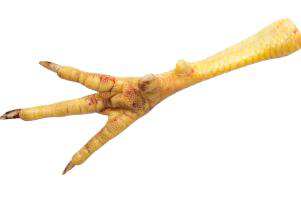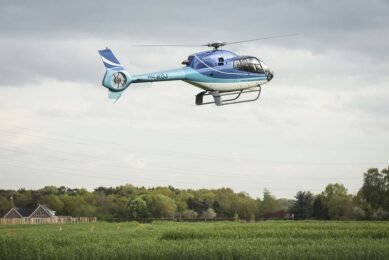Nutritional interventions can prevent pododermititis

Pododermititis or foot pad lesions is one of the main indicators of welfare status in broilers. Wet ?litter due to digestive inefficiency can initiate lesion development. In order to maintain foot pad integrity, suitable nutrition is required to ensure skin robustness, which prevents lesion formation. Using a combination of natural forms of minerals and immune enhancing products make lesions less likely to form and may prevent secondary infections in established lesions.
By Dr Jules Taylor Pickard, Alltech and Prof Peter Spring, Swiss College of Agriculture
Pododermititis (foot pad lesions) is an important welfare problem in poultry, mainly in broilers and turkeys, kept on litter floors, where the birds can develop foot lesions of varying degrees due to damage from the litter. In terms of codes of practice for poultry, the development of these lesions affects two of the ‘five freedoms’, i.e. freedom from discomfort and freedom from pain, injury and disease. A third – ‘freedom to express normal patterns of behaviour’ – could be added to this list if the lesions affect the bird’s ability to walk. According to the Farm Animal Welfare Advisory Council, flock-keepers must check for such problems daily and take advice from nutritionists and veterinarians regarding controlling these lesions, and must also seek feedback from processors at the slaughterhouse regarding the quality of each flock’s feet (see the Farm Animal Advisory Council Code of Practice for the Welfare of Broiler Chickens).
Extra burn effect
So what is pododermititis (or foot pad dermatitis (FPD) as it’s often know), what causes it and how can it be controlled from a nutritional point of view? The lesions are primarily caused by wet and sticky litter, leading to damage and burns on the sole of the foot. Ammonia present from excreta in the litter is linked to the extra ‘burn’ effect seen in terms of the visible damage. The lesions start as an eroded part of the plantar surface of the foot, and once this damage is established, the lesion continues to develop, leading eventually to a black blister-like formation. Such damage can also lead to skin infections, as well as reducing the bird’s ability to walk, and can therefore reduce feed and water intake.
Overall, the effects of FPD in terms of welfare are considerable, which is why, in 2005, the EU proposed that the incidence of FPD in broilers should be used as one of the main indicators of welfare status, forming the basis of recommendations on future stocking density for farms. Scoring systems have been published for both broilers and turkeys to assist in establishing the severity of lesions in flocks. In some counties in Scandinavia, welfare monitoring is based on FPD scores, and affected flocks may be culled rather than processed, at great cost to the producer.
In economic terms, the effects of FPD are of major importance. Because the birds ability to walk, feed and drink is reduced so is their performance when compared with their unaffected flock-mates. The sale of feet to Asian countries, where they are a delicacy, is also severely affected when FPD is evident.
Other factors have been identified which have a bearing on FPD incidence and severity. De Jong, in 2011, identified a seasonal effect, whereby FPD is more prevalent and severe during the winter months, compared to summer, based on studies conducted in Denmark and Sweden between 2002 and 2010. This may be due to ventilation, which is known to impact on the development of lesions due to ammonia emissions from litter. The presence of certain bacteria, especially Staphylococcus and E.coli species, can lead to secondary infections of the lesions, furthering the severity of the problem and even causing joint inflammation. The types of water systems used as well as heating, ventilation, lighting patterns and stocking density, all contribute to FPD, but the aim of this article is to investigate the impact of feed and nutrition on this problem.
Impact of feed on PFD
Certain raw materials are known to affect the development of FPD, as they can cause wet litter and hence initiate the development of lesions. Feed materials that are high in potassium (e.g. soya, manioc) can cause wet droppings, leading to poorer litter quality due to the negative effect of potassium on water resorption in the gut. Non-starch polysaccharide intake from cereals such as wheat and barley is also a well-known cause of wet litter and contributes to dysbacteriosis in the gut, leading to wet droppings which may also be contaminated with pathogenic bacteria. Poorly digested protein will add to the levels of excreted nitrogenous material and hence ammonia, which develops in the litter, adding to the burn damage to the feet. Researchers have suggested the use of various alternative feed materials, such as organic minerals, and specialist supplements to support skin strength and immune response to potential secondary infections.
Prevention of lesions and infections
Prevention is the most desirable way of addressing FPD, as this not only reduces the requirement for expensive veterinary intervention, but also maintains the integrity of the foot pad in its ideal form (i.e. without scarring), preventing downgrades at slaughter and economic losses, as well as satisfying welfare standards. In order to maintain foot pad integrity, suitable nutrition is required to ensure skin robustness, which prevents lesion formation.
In a trial conducted in turkeys fed diets with either inorganic or lower levels of organic minerals, the FPD incidence was monitored and reported. Birds received either a control, inorganic mineral diet containing 15 ppm added Cu plus 60 ppm added Zn, Mn and Fe or an organic (chelated) mineral diet formulated with 2.5 ppm added Bioplex Cu plus10 ppm Bioplex Zn, Fe and Mn. Ninety-six birds per treatment were used in a replicated trial design. The results showed that, at 12 weeks of age, the turkeys fed the organic mineral diet had no FPD on their feet, whereas foot lesions for the control group were at least score 1 (mild burns on one leg), with one animal showing burns on both feet (score 2). This result was attributed to better skin integrity in those turkeys fed the organic mineral diet, even at a lower inclusion rate. Other research examined the role of organic forms of minerals on skin development in broiler chickens. Birds were fed either an inorganic
control or a diet containing chelated (organic) selenium and zinc. The figure below shows the difference between histological assessment of the groups.
Work by Youssef et al investigated the role of biotin, zinc and mannan-oligosaccharides (as an immune modulator) in the incidence of FPD in turkeys. They found significant improvements in FPD scores on dry litter with any one of these feed ingredients compared to broilers kept on wet litter. This may be enhanced if the effects on ammonia production in wet litter are also addressed by enzyme supplementation or using different, more digestible
protein sources.
In a review by Costa et al , the role of nutrients and specialist supplements are discussed. The inclusion of supplements such as enzymes is highlighted regarding reducing digesta viscosity and hence minimising the production of wet litter, and showed that diets using enzymes to address these factors lowered viscosity, resulting in a reduction in the incidence of FPD in broilers. There was a positive relationship between viscosity reduction and improved litter dryness, leading to a lower incidence of foot pad wounds, especially in older birds.
Research conducted by Nagaraj, in 2006, looked into the role of protein level and enzyme addition on FPD in broilers. This work revealed that
broilers fed high levels of protein
had increased FPD (in terms of both incidence and severity), and feed enzyme supplementation reduced this, as a direct consequence of increased protein digestibility and reduced ammonia emissions from litter.
Nutritional interventions
The application of appropriate nutritional interventions can prevent or alleviate the development of FPD. Using natural forms of minerals can enhance skin integrity, making lesions less likely to form. In addition, immune enhancing products, such as mannan-oligosaccharides, may prevent secondary infections in established lesions. Ensuring good protein digestibility has an impact on ammonia produced from litter, reducing foot pad burns, and so either a more digestible form of protein or the
addition of a proven protease enzyme will assist in reducing lesion incidence. Preventing wet litter from NSP in the diets (from cereals predominantly) by adding a suitable glucanase and/or xylanase product help to prevent the initial development of lesions. Using a combination of these approaches in feed can assist in the prevention of FPD, leading to fewer downgrades and slaughter and improved welfare of birds kept on litter.
Article featured in World Poultry issue 29.2
Join 31,000+ subscribers
Subscribe to our newsletter to stay updated about all the need-to-know content in the poultry sector, three times a week. Beheer
Beheer








 WP Admin
WP Admin  Bewerk bericht
Bewerk bericht